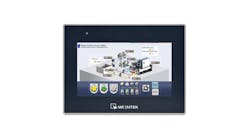Big and bigger data is zipping from sensors, transmitters, processes and plants over Ethernet networks to control systems, enterprise levels, Internet servers and the cloud. However, because users still learn most of what they need to know through their peepers, human-machine interfaces (HMIs) remain crucial points for analysis and optimization—even as their workstations, consoles and laptops are joined by tablet PCs and smart phones.
Likewise, not only are the types and sizes of HMIs increasing, they're also gaining greater mobility, following their users and applications into settings where they haven't served before, and enabling the latest data-to-decision efforts. So, what are the best ways for these interfaces, screens and displays to serve today's accelerating, Internet-based applications and settings?
Where interfaces fit in
"We've heard so much talk about the Industrial Internet of Things (IIoT), big data and the cloud, but when we get down to brass tacks, you have to ask what can we actually do with it, and how can we implement it? HMIs pique our interest because we can do a lot with available technologies," says Will Aja, customer operations VP at Panacea Technologies Inc., a CSIA-member system integrator in Montgomeryville, Pa. "In addition, despite the talk about Ethernet and IIoT, there's not a lot of discussion about security, and how easy these new technologies can be to manipulate and change.
[sidebar id =2]
"As a system integrator that's responsible for deploying new solutions safely, we ask users to think about convenience and functionality versus safety, and only implement what's needed. Don't just put an Ethernet plug on a valve or make it Internet-capable without looking at what you're really going to get out of it. For example, life-science applications produce a lot of data, but it needs to be contextualized. Oftentimes, if legacy devices aren’t capable of generating the desired data and your infrastructure has to be modernized. HMIs are an example of a low hanging fruit for modernization because they can be designed to deliver data and allow interactions to different user groups in ways that make sense to each group. They can also have multi-layer security and audit trails as part of a larger enterprise network."
For instance, when Baze Chemical built its new ethyoxylation plant in Palestine, Texas, during 2013-2015, it worked with system integrator Coherent Technologies Inc. in Palestine to build a supervisory control and data acquisition (SCADA) system that could meet the facility's evolving requirements. Ethoxylation is a chemical process that creates surfactant compounds to lower the surface tension of liquids, and Baze needed flexibility for devices, including its annunciator to alert operators about unusual conditions such high temperatures (Figure 1).
"We found it very difficult to figure out the design for the annunciator without having to expand it shortly after as the plant grew," says Timothy Triplett, founder and CEO of Coherent, which created a virtual annunciator by using Ignition SCADA software from Inductive Automation. Its screen hangs on a wall of the plant’s control room, visually and audibly alerts Baze's operators about the status of multiple devices, and lets them monitor alarms coming through the system without disrupting their normal screens.
"With the virtual annunciator, we created a flexible, independent Ignition system with its own server, PLC and display—all within the same budget as a hardware annunciator,” explains Triplett, who adds that a second annunciator was needed as soon as the first was finished, but it was easy to add because of Ignition's platform independence and unlimited client licenses.
Mobility unleashes capability
[sidebar id =3]
No doubt the most significant trend in HMIs is their move onto mobile devices and mobile apps. "While there’s still a need for a ruggedized industrial HMI to be physically located on the manufacturing line or a machine itself, there’s increasing adoption and use of commercially available, off-the-shelf tablets and smartphones in industrial applications," says Matt Newton, technical marketing director at Opto 22. "We’re starting to see overall equipment effectiveness (OEE) and KPI data pushed out to mobile devices via third-party apps, so operators have real-time access to how efficiently their machines and manufacturing lines are running. This move to mobile also frees up operators to move about the factory, so they’re not tied to a particular HMI screen or portion of the manufacturing line or process. Using mobile devices allows operators to effectively be in multiple places at the same time."
For example, 30-year-old Natural Fruit Corp. in Hialeah, Florida, has a process automation system for manufacturing and storing its frozen fruit bars, but its refrigeration rooms and equipment must run 24/7/365, and until recently, its existing Mycom Refrigeration system still required staff to visit the plant on weekends to make sure it was running properly. To add remote monitoring, notification and control to Mycom's serial network and Modbus protocol, Natural Fruit project manager Jonathan Bravo initially found technologies that were cumbersome, difficult to integrate, and required lots of programming and development time, but then settled on Opto 22's groov Box appliance and Snap-PAC-R2 programmable automation controller (PAC) (Figure 2).
Bravo reports he quickly integrated several of Natural Fruit's systems into groov screens for mobile devices, and Snap-PAC-R2 pulled data point from several of its Modbus components. Once these points were in the controller, groov let Bravo build mobile screens for monitoring the plant's Freon detection sensors, cold room temperatures and condenser tower. Also, Snap-PAC's logging feature let him log compressor run-time data to the controller, and use FTP to move the log files to central data storage. He also implemented an alerting and notification system with groov’s Events and Messaging feature, so if the plant's Freon sensors detect it anywhere in the facility, they can trigger the controller to immediately notify the operators and quickly resolve any situations.
“The drag-and-drop interface on groov was extremely easy to use,” says Bravo. “groov was the only solution we came across that offered such a quick way to get up and running with mobile devices connecting to our existing systems.” Bravo adds that Natural Fruit's production line is presently run by a Siemens S7 PLC, so his next automation project is to integrate its functions into the groov interface. This will allow operators to do remote production monitoring from anywhere in the facility.
"There are many benefits to moving to a mobile device for HMI use in process applications, but it’s important to choose the right type," adds Newton. "For most applications, an off-the-shelf tablet or smartphone is more than adequate, but for applications that require intrinsic safety, it’s important to consider C1D2/C1Z2 and ATEX-compliant tablets for hazardous locations (HazLoc). ATEX certification is based on the requirements of two European directives: Directive 99/92/EC (also known as ATEX Workplace Directive) and Directive 94/9/EC (ATEX Equipment Directive). Both C1D2 and ATEX standards are commonly recognized in most regions of the world, and both offer comparable levels of rugged mobile work protection in hazardous locations."
Flexibility boosts multitasking
Beyond granting mobility and access, upgrading HMIs can enable greater comprehension and efficiency in more stationary applications and facilities. For example, the City of Ann Arbor, Mich.'s Wastewater Treatment Plant (WWTP) is four years into a phased, five-year project to renovate and expand the 30-million-gallon per day (mgd) capacity of its two main plants. WWTP serves about 130,000 residents in and around Ann Arbor. Average daily processing is about 18 mgd, which has helped WWTP maintain its required 24/7 operations.
Because the blowers in Ann Arbor WWTP's aeration system are crucial for providing air to microorganisms or "good bugs" consuming dissolved solids at the plant, upgrading them was also essential. "This was a big issue for us," says Earl Kenzie, P.E., manager of WWT services for Ann Arbor. "These blowers were previously constant-speed, and so it was important to move them to variable-speed and take up less space." Kenzie reported the migration allowed the blowers to save 30% on power, which saves WWTP $85,000-$90,000 per month.
WTTP is also working with system integrator Commerce Controls Inc. of Novi, Mich., which helped it implement a PlantPAx control system, scalable ControlLogix controllers and redundant servers from Rockwell Automation.
Because the utility wanted to adopt some virtual tools, Kenzie and Jeff Krawczyk, senior sales engineer, Commerce Controls, also checked on using pre-built virtual machines (VM) from Rockwell Automation on virtual servers. The team also held graphics development meetings to design new HMI displays, including screens with three PlantPAx software objects for trend areas such as return activated sludge (RAS) pumps and RAS flow to aeration. "This lets operators view profiles for several processes at once, and then click on individual areas such as clarifiers and sludge pumps to see if they're discharging the right number of gallons, or reading airflows for the aeration tanks." says Krawczyk. "Plus, WWTP can also use these displays to train operators and SCADA supervisors."
[pullquote]
Overall, the HMI side of WWTP's upgrade project has included development of 425 screens that display data from 15,000 tags and 36 wastewater processes, which are managed by four older PLCs, and 30 ControlLogix and CompactLogix controllers. Kenzie and Krawczyk add the VMs have reduced the upgrade's deployment time, and made the plant's infrstructure more robust, while their graphics effort also reduced configuration time.
Likewise, Enerchem International Inc.'s crude oil fractionation plant in Slave Lake, Alberta, recently migrated from an outdated HMI that "reported using a different vendor's software package, exported to a primitive database, and generated reports in Microsoft Excel," says Kyle Chase, CEO at system integrator Kymera Systems in Leduc, Alberta. "It wasn't very manageable or accessible."
Kevin Bouchard, plants and terminals director at Enerchem, adds, “With the previous HMIs, we had to have two to three operators on each panel to control it.”
With just over 30,000 tags, Enerchem's fractionation process required an interface system that could manage the entire plant with more precision and efficiency, so with Kymera's help, it also adopted Ignition software and its flexible HMI, SCADA and MES solution. It took advantage of Ignition's cross-platform OPC-UA server to easily connect with multiple Ethernet/IP and Modbus networks. Ignition acts as an OPC-UA client, connecting to many PLCs at the plant with embedded OPC-UA servers. This lets all of Enerchem's facilities share live plant information. Meanwhile, Ignition's Java-based platform let Kymera customize Enerchem's HMI system, implement a database that allowed easy access to years of plant data, and set up remote access and individual user accounts.
As a result, Enerchem reports that one operator can control 10-15 different processes at the same time, instead of having two to three operators on an HMI panel, which reduces labor costs and boosts work output. Ignition has also helped the plant become more efficient by giving operators more power to reduce waste and manage the fractionation process.
“With real-time remote access and trending capabilities, the overall effiency of the yield of the product as compared to the crude we consume is much better," adds Bouchard. "Ignition has been an economical and profitable system for us.”
Interfaces character changes
Just as digitalization is shifting many functions of sensors, transmitters, controllers and other devices from hardware to software, the nature of HMIs is evolving, too.
"The industry has been moving away from physical HMIs and implementing server-client architectures for some time, but now we're also using this methodology to serve up whole SCADA systems and batch processes on tablets of different sizes and across various parts of a process, such as bioreactors," explains Panacea's Aja. "The difference now is we're delivering automation information in the same way that users interact with their consumer technologies at home. This makes it easier to teach new users on tablets, amd makes migrations much simpler by decoupling the hardware portion.
"Tablets can also use color-coded QR codes to control equipment functions, take photos or videos of processes, scan staff IDs and request passwords. This is all done with tight control over operator access and security, while generating robus audit trails. Users also can rotate sets of tablets, which eliminates the need for a vast quantity of physical PCs and panel-mounted HMIs. With added software, they can just pull an application and specific documents for the equipment they're working on. We're also adding batch functions, so this platform can be used across multiple processes."
Aja adds the beauty and value of virtual HMIs like Panacea's tablet-based thin clients is that they're based on commercial, off-the-shelf (COTS) technology, which is less costly and easier to support, patch, migrate and secure without additional programming or components. "For instance, our solution is based on ACP ThinManager software that runs on any tablet, but all the calculations happen in the server environment, which takes the physical panel away—along with the worries of maintaining and migrating it—and delivers everything back to a simple tablet. This is a real game changer. This is why the IIoT movement isn't just about adding devices, but is really about empowering users to make better decisions more quickly and securely."
Opto 22's Newton adds, "Similar to the transition we’ve seen from desktop PCs to mobile devices in the commercial and consumer markets, over time I think mobile devices will become the standard platform for HMIs in the industrial markets. There may be new hardware revisions added to mobile devices to increase their ruggedness, but it’s clear that the future of HMIs lies in mobility and rapid access to operational information from new sources of information like databases and web servers."





